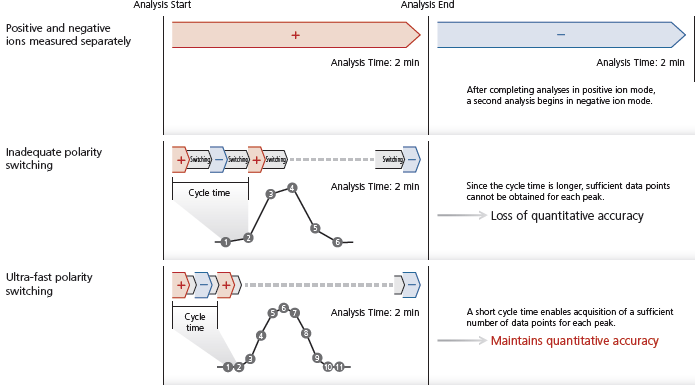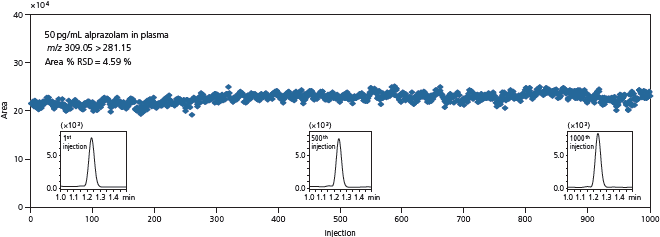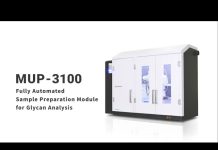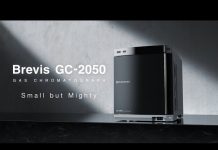
Thanks to a heated ESI probe and the UFsweeper III collision cell, the LCMS-8050 achieves a level of sensitivity 30 times that of the LCMS-8030.The UF Technology, the ultrafast measurement technology built into the LCMS-2020 has further evolved, so measurements can now be performed even faster, without sacrificing data quality. At the same time, more compounds can now be measured in simultaneous qualitative and quantitative analysis. The system can be used in a wide range of fields for a variety of applications, such as quantitative analysis which requires high sensitivity, multicomponent simultaneous analysis, and screening.
UFsensitivityTM
High Sensitivity for Trace Quantitative Analysis
■Heated ESI Probe
In order to improve desolvation efficiency, the newly developed heated ESI probe combines a high-temperature gas with the nebulizer spray, assisting in the desolvation of large droplets and facilitating ionization. This development allows for high-sensitivity analysis of a wide range of target compounds.

■Excellent Reproducibility Even at Attogram (ag) Levels

Both sensitivity and reproducibility are essential when establishing low limits of quantitation. High-precision quantitative results obtained with the LCMS-8050 in the analysis of Verapamil in blood plasma at levels between 500 ag and 50 pg are shown below. Excellent reproducibility with a % RSD of 2.77 % was obtained when analyzing just 500 ag of Verapamil. The LCMS-8050 demonstrates optimal performance for quantitative analysis of even trace components of a complex matrix.
| Concentration actual ng/mL | Calculated concentration ng/mL | % RSD (n = 6) | Accuracy (%) (n = 6) |
| 0.000500 | 0.000501 | 2.77 | 100.2 |
| 0.00500 | 0.00496 | 3.98 | 99.2 |
| 0.0500 | 0.0506 | 1.21 | 101.2 |
| 0.500 | 0.493 | 1.31 | 98.6 |
| 5.00 | 4.89 | 1.81 | 97.8 |
| 50.0 | 51.6 | 0.65 | 103.2 |
UFswitchingTM
Polarity Switching Technology with No Compromise in Quality or Sensitivity
■High-Sensitivity & High-Speed Positive/Negative Ionization Switching in 5 msec
Just One Minute per Analysis
A Case Study Using High-Speed Positive/Negative Ionization Switching
When performing simultaneous positive/negative ion measurements of multiple components, the proper acquisition of sharp UHPLC peaks depends on rapid polarity switching. The LCMS-8050 minimizes losses due to polarity switching and ensures the collection of sufficient data points for even the narrow peaks obtained with UHPLC, recording accurate peak shapes and allowing excellent reproducibility.

■Only 5 msec to Achieve Stable Quantitative Accuracy with Positive/Negative Ionization Switching

The LCMS-8050 uses unique high-voltage power supply technology to achieve an ultra-high-speed positive/negative ionization switching time of just 5 msec. The LCMS-8050 is also the only instrument of its type to maintain ion intensity even when performing polarity switching at ultra-high speed, yielding consistent, reproducible data. Excellent quantitative results can be obtained from UHPLC peaks no more than 2-3 seconds wide, even when multiple components are eluted simultaneously.
■Outstanding Throughput and Quantitative Accuracy

UFscanningTM
Simultaneous, Highly Reliable Quantitative and Qualitative Analysis
■High-Sensitivity & High-Speed Scanning at 30,000 u/sec
Simultaneous Quantitative and Qualitative Analysis Simultaneous High-Speed Screening of 12 Toxicological Drugs
The LCMS-8050 is capable of simultaneously obtaining both qualitative and quantitative information in a single analysis. Acquisition occurs so rapidly that MS/MS scans and MRM measurements can be performed concurrently while maintaining quantitative accuracy. MS/MS scans are usable and reliable because even at 30,000 u/sec, Shimadzu uses a 0.1 u scan step.

■Maintain Sensitivity and Mass Accuracy Even at 30,000 u/sec
By controlling the voltage applied to the quadrupoles according to scan speed and m/z, the LCMS-8050 achieves superior ion transmission at any scan speed. And because Shimadzu maintains data collection at 0.1 u intervals, high-quality mass spectra are obtained without loss of sensitivity or mass accuracy.

■Efficient Qualitative Analysis Using Synchronized Survey Scan
The Synchronized Survey Scan (SSS) function allows MRM acquisition to be combined with a variety of other scan modes. It is extremely useful for obtaining more detailed qualitative information on components detected during multi-analyte quantitative acquisition.

One thousand events can be registered within a single method. It allows setting of optimum collision energies for each component in order to obtain only the required qualitative information.
UF-MRMTM
■ High-Sensitivity & High-Speed MRM at 555 ch/sec
Detect Target Compounds at Trace-Level Concentrations Simultaneous Analysis of 29 Pesticides for Water Quality Analysis
The LCMS-8050 is capable of simultaneously acquiring 555 MRM transitions per second while maintaining accuracy and precision. Sufficient data points can be collected for quantitation ions, reference ions, and internal standard ions even in chromatographic regions with unresolved peaks. The high sensitivity of the LCMS-8050 allows for trace-level analysis, such as pesticides in drinking water, without the need for sample pre-concentration. This high sensitivity is maintained even when monitoring numerous MRM channels.

Engineered for Robustness and Easy Operation/Maintenance
■Maintains High Sensitivity Even During Successive Demanding Analyses
In addition to speed and sensitivity, Shimadzu designed the LCMS-8050 for robustness to meet the most demanding laboratory requirements and most difficult matrices. The figure below plots the area results from 1000 consecutive analyses of a deproteinized blood plasma sample spiked with alprazolam. The LCMS-8050 achieves excellent reproducibility with a 4.59 % RSD for the area results over the 1000 analyses.

■Easy System Maintenance Reduces Downtime
As with Shimadzu’s other triple quad systems, maintaining the LCMS-8050 is simple. Replacing the desolvation line (DL) and ESI capillary is quick and easy. Additionally, the design allows users to replace the DL without breaking vacuum, providing greater uptime and usability.
● Steps for DL Replacement

● Steps for ESI Capillary Replacement

































